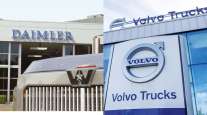Managing Editor, Features and Multimedia
Volvo Trucks Showcases Active Driver Assist; System Uses Alerts, Braking to Prevent Crashes

This story appears in the Oct. 31 print edition of Transport Topics.
MOUNTVILLE, S.C. — Volvo Trucks North America showcased the next generation of collision- mitigation technology available on its trucks and touted the product offering as its latest effort to enhance road safety.
The original equipment manufacturer provided trucking journalists with ride-alongs in a Volvo tractor equipped with the Bendix Wingman Fusion active safety system during an Oct. 24 event here at the Michelin Laurens Proving Grounds.
The technology, which the OEM is marketing as Volvo Active Driver Assist, combines a bumper-mounted radar sensor with a windshield- mounted camera to track both moving and stationary vehicles as well as lane markings.
During the demonstration, the system generated increasingly urgent audible warnings as the truck approached a slower-moving passenger vehicle ahead on the test track and eventually applied the brakes automatically to prevent a forward collision. Moments later, the technology brought the truck to a complete and abrupt halt as it rapidly closed in on a stopped passenger vehicle.
Active Driver Assist also includes adaptive cruise control and can provide enhanced lane-departure warnings with the aid of the camera.
Ash Makki, product marketing manager at VTNA, likened the combination of camera and radar to “two brains thinking together to make sound decisions.”
He also said Volvo has integrated the safety system with its trucks’ driver information display, which prioritizes the most critical alerts.
In addition, the system can capture video based on triggers such as excessive braking and hard turns.
Volvo is offering Active Driver Assist on its VNL and VNM models. The truck maker first announced the product option earlier this month at American Trucking Associations’ Management Conference & Exhibition in Las Vegas.
On a second truck pulling a full tank trailer, Volvo demonstrated how its enhanced stability technology can prevent rollovers, jackknifes and other loss-of-control accidents.
Also at the event, Volvo customers shared their experiences with active safety technology.
McKenzie Tank Lines, a bulk carrier based in Tallahassee, Florida, has seen a sharp decline in rollovers and rear-end collisions since deploying safety systems such as forward-collision and lane-departure warnings and electronic stability control, said Jim Kennedy, vice president of maintenance.
The 275-tractor fleet has been involved in a total of four rear-end collisions over the past four years, he said, marking a dramatic decline from the 2003-2007 timeframe, when it averaged nearly 10 such crashes each year.
McKenzie also has had only one rollover event in the past six years. From 2003 to 2008, it averaged two per year.
Furthermore, every vehicle involved in those events was not equipped with the active safety technology that might have prevented it, Kennedy said, noting that the rollout of the technology has been occurring over time as the fleet purchases new equipment. “That speaks volumes.”
While McKenzie has been an early adopter of safety technologies, Kennedy said it’s a “bit ridiculous” how long it sometimes takes for these systems to achieve broad customer acceptance.
He later said the slow adoption is often tied to the cost of the technology.
Kennedy estimated that McKenzie’s investments in safety systems, including disc brakes, probably add more than $8,000 to the price of each truck, “but when you look at the numbers we have regarding rear-end collisions and rollover events, we can justify that.”
Many other fleets haven’t experienced the technology or haven’t seen enough data to validate it, he added.
Hill Bros., however, recently has begun to deploy adaptive cruise control and collision mitigation in its 340-truck fleet.
The Omaha, Nebraska-based refrigerated carrier decided to purchase those systems primarily as a way to prevent rear-end accidents, said John Beverage, director of maintenance.
“Driver acceptance of it is getting a lot better as well,” he said. “Change is hard for a lot of people.”
Fred Andersky, director of customer solutions and director of government and industry affairs at Bendix Commercial Vehicle Systems, agreed that industry adoption of collision mitigation appears to be gaining momentum, adding that these types of active safety systems represent the foundation for further automation on the path to self-driving vehicles.
Andersky, who drove the Volvo truck equipped with Active Driver Assist during the test-track demonstrations, predicted that federal regulators might issue a proposal to require collision mitigation on new trucks within the next few years, which could lead to a final rule around 2021 and implementation around 2023. The technology already has been mandated in Europe.
In addition to Volvo, Bendix Wingman Fusion is currently available on trucks built by Navistar Inc., Peterbilt Motors Co. and Kenworth Truck Co., Andersky said.




